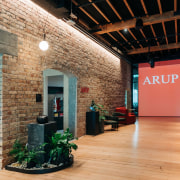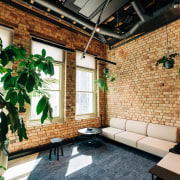Kaitiakitanga – a commercial perspective
A global sustainable development consultancy's new Auckland office, by Unispace, offers a commercial model for green guardianship
Project: Arup offices, Britomart, Auckland
Designed by Unispace
From the interior designers:
Global sustainable development consultancy Arup is targeting an ambitious sustainability accreditation for its new offices in Auckland’s historic Britomart, seeking to gain Living Building Challenge certification.
In taking on this challenge, Arup and its building partners were able to divert more than 99% of construction waste away from landfill while offsetting the fit-out’s carbon footprint.
In line with the project’s commitment to sustainable outcomes, the new office will be powered by 100% renewable energy.
The Living Building Challenge asks the building industry to stretch their sustainability goals, striving to leave a positive impact on the health and wellbeing of people and planet.
This aligns with Auckland Council’s Zero Waste by 2040 goal as well as the te ao Māori (the Māori world view) concept of kaitiakitanga (guardianship) to sustain and restore our collective resources.
The new, custom designed 620m² office space is designed with sustainability at the heart.
Key features
- Resource efficiency: the office is designed to use 35% less power, and 30% less water than an equivalent building.
- Carbon accounting: whole life embodied carbon has been accounted with reduced overall emissions and our upfront impact will be offset.
- Sustainable and toxic free materials: all timber used in construction is responsibly sourced, verified with FSC certification, with chain of custody maintained from responsible forests all the way to our office – further, at least 90% of materials are free of harmful components outlined in the Living Futures Institute's Red List.
- Biophilic design: the multi-sensory focal point of the Whatu stone with continuously flowing water surrounded by planted punga logs, the retreat space with large plants, and the Strandboard wall finishes, all celebrate connection to place, natural materials and New Zealand cultural significance.
The independent Living Futures Institute will assess the building’s performance after 12 months to ensure it is genuinely having a positive impact on the environment and the people who use the space before certifying that it fulfils the Living Building Challenge.
The certification is globally recognised as the leading international standard for sustainable buildings that protect and restore the natural environment.
Other notable offices that feature certification from the International Living Futures Institute include Google’s Sunnyvale campus and Etsy’s Brooklyn headquarters.
Located at 15 Galway Street next to Britomart train station, in the heart of Auckland's vibrant waterfront precinct, the office enjoys excellent transport connections to the new city rail link, Downtown ferry terminal, and bus station – providing easy access to the desirable boutiques, award winning restaurants, bars, galleries, and public open spaces that define this celebrated destination.
Mayurie Gunatilaka, New Zealand country leader at Arup says sustainable development is at the heart of Arup’s purpose so it made sense to strive for the most rigorous sustainability credentials in designing the new Auckland offices.
"The team worked hand in glove with our contractors to ensure that the design left a net positive impact on the environment.
"They went above and beyond to minimise impacts, communicating regularly with suppliers who took back and recycled offcuts, and even recycling plaster dust generated in construction for use in compostable toilets."
Pāora Puru, director, Te Manu Taupua says it was important that the project involved working collaboratively with Mana Whenua iwi from the early stages of the planning and design process.
"The intention was to create a space which reflects the values of kaitiakitanga in minimising impacts to nature, re-using and upcycling as much as possible to reduce waste going to landfill, and adopting naming conventions that recognise the significance of local cultural landmarks.
"Whatungarongaro te tangata, toitū te whenua - As people disappear from sight, the land remains.”
Darcy Utting, principal design, Unispace says the design and construction industry is in a powerful position to make meaningful change for our environment, starting with building an understanding of kaitiakitanga.
"The Unispace team in partnership with Arup’s sustainability specialists achieved incredible energy performance and waste diversion in the project’s end-to-end delivery.
"This is an exemplar for the New Zealand market – and especially critical for all Government agencies and their contractors to provide sustainable fit-outs across our country’s property portfolios.”
Designed by: Unispace
Story by: Trendsideas
Home kitchen bathroom commercial design
Diving into nature
Classic looks, contemporary efficiency
Personality plus















